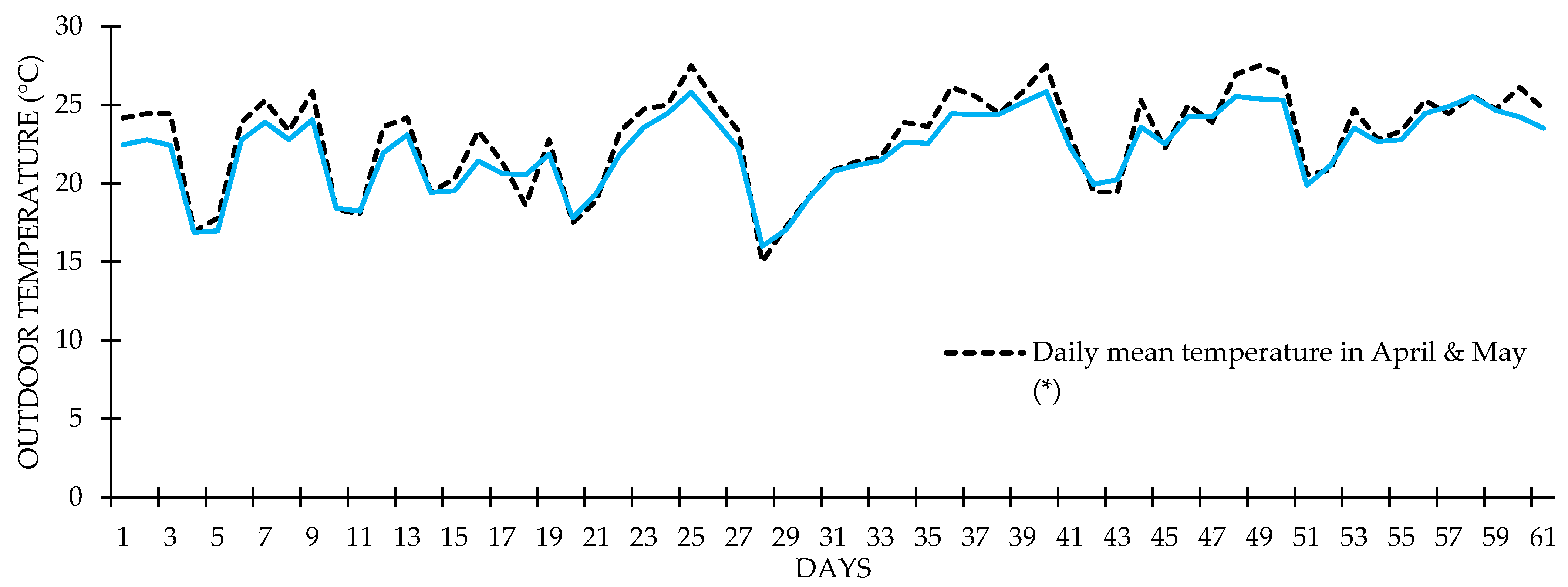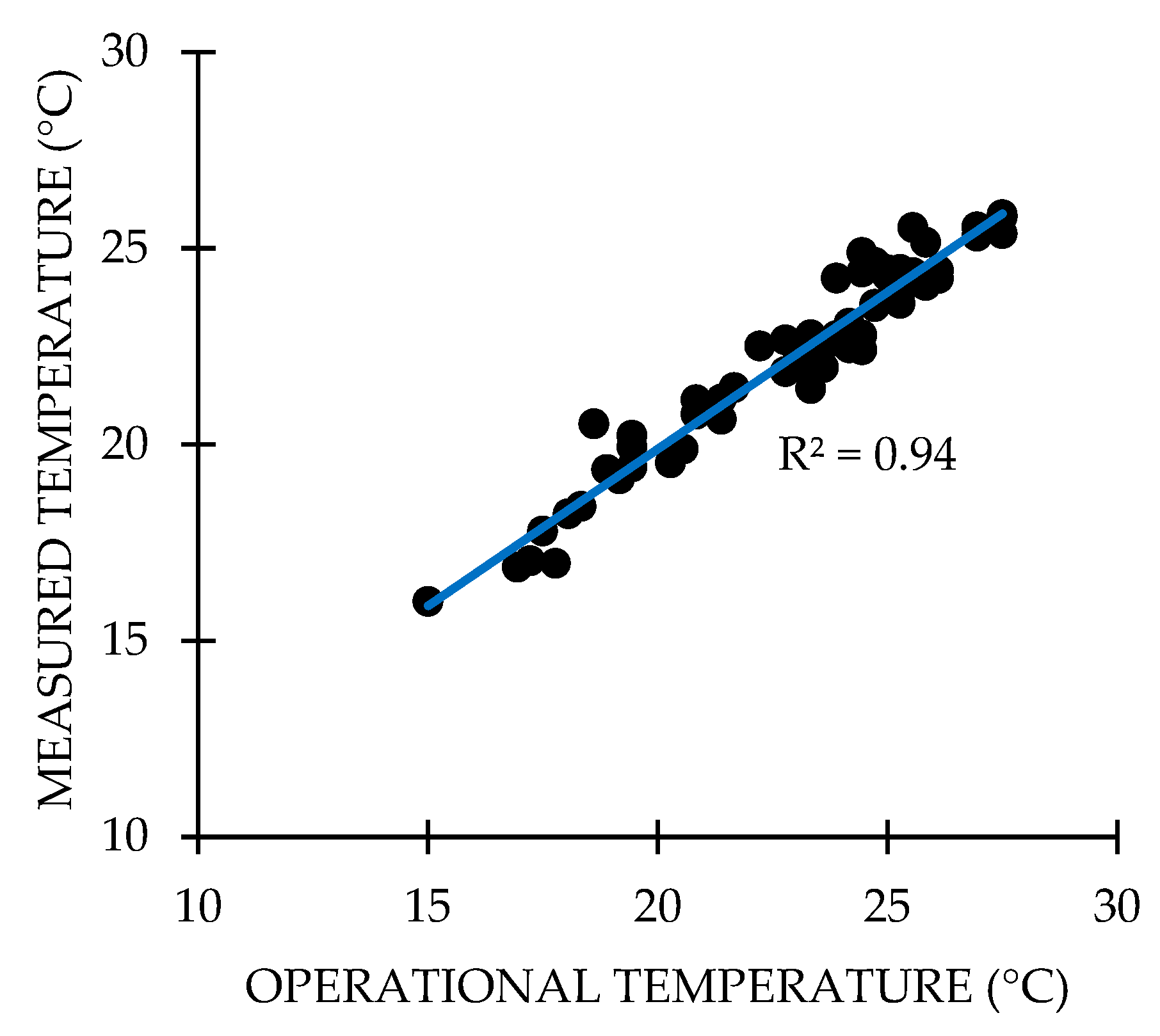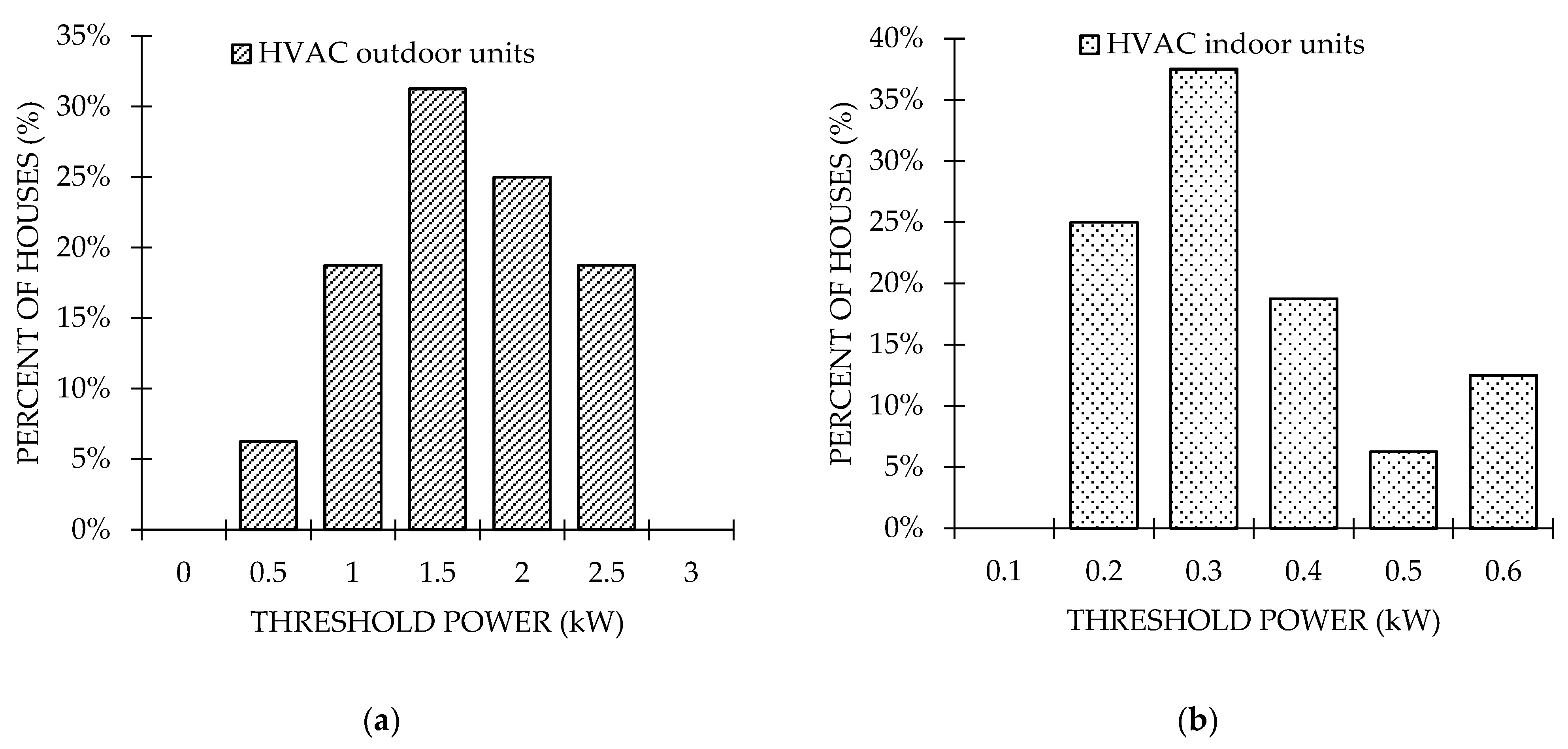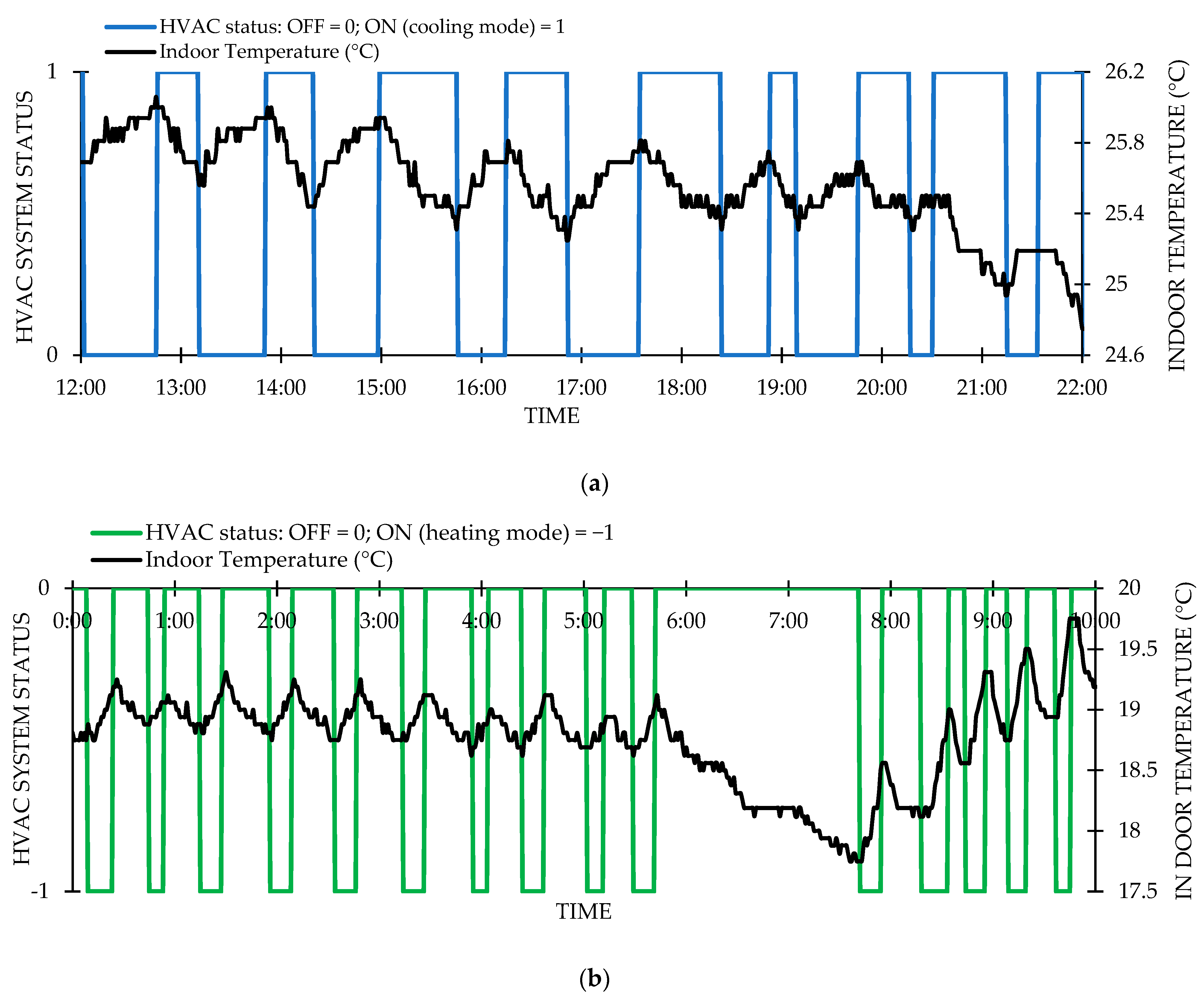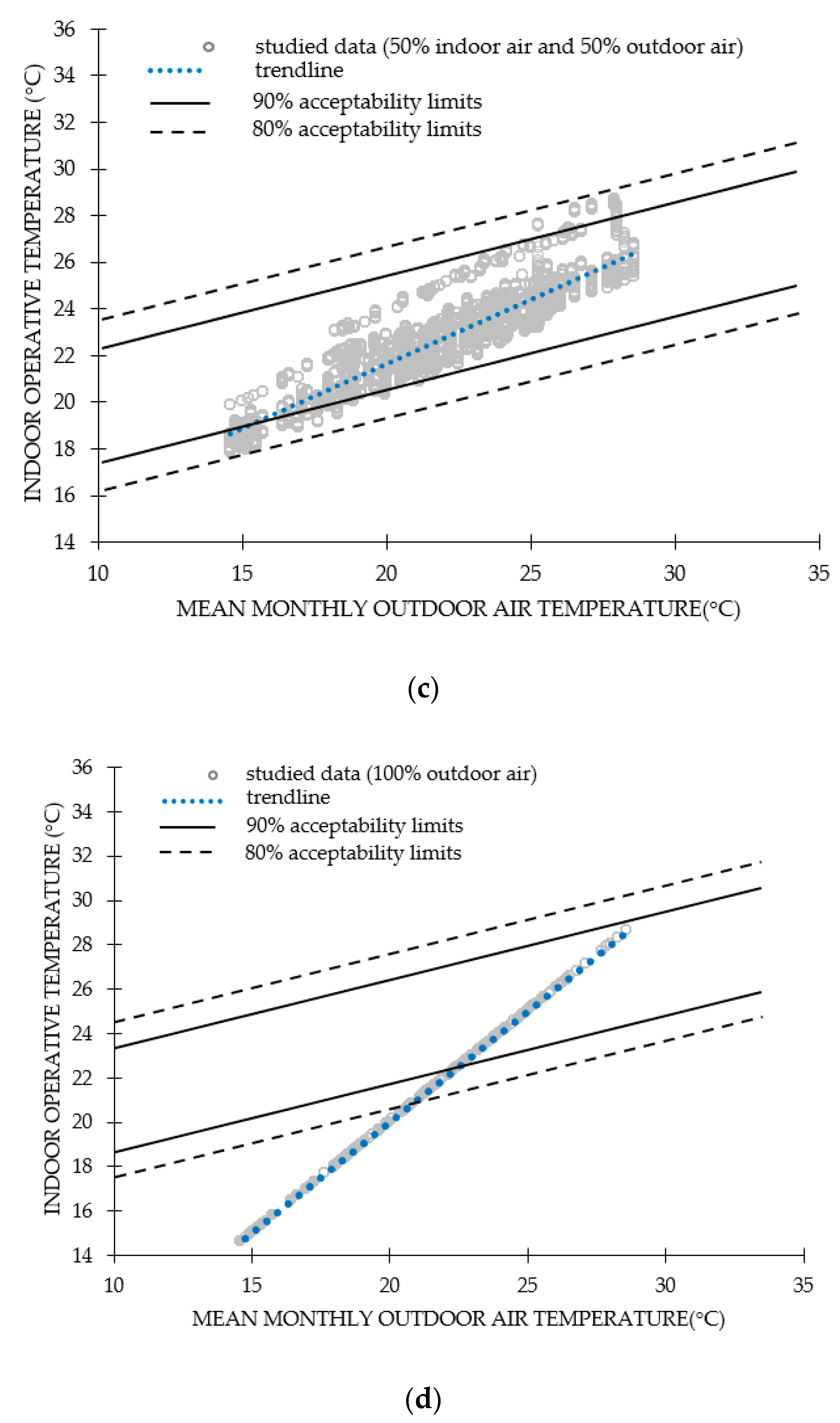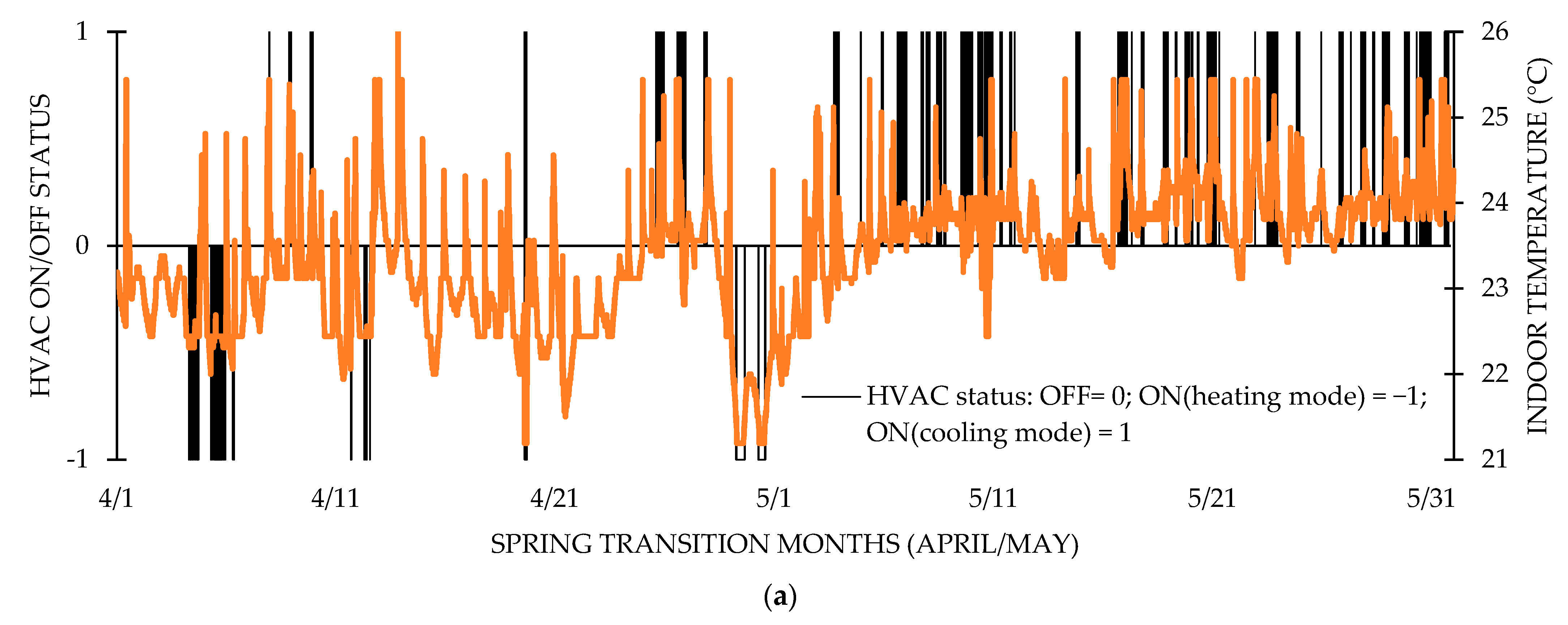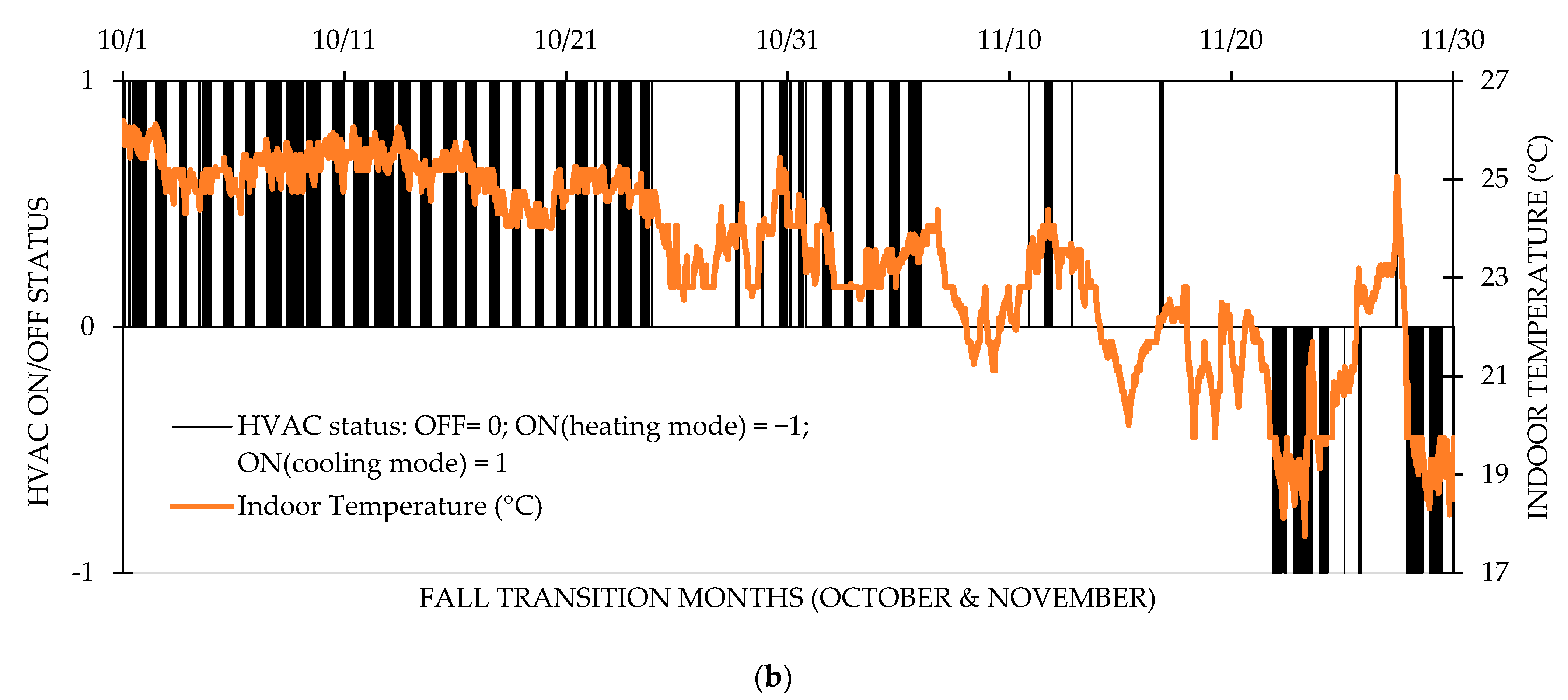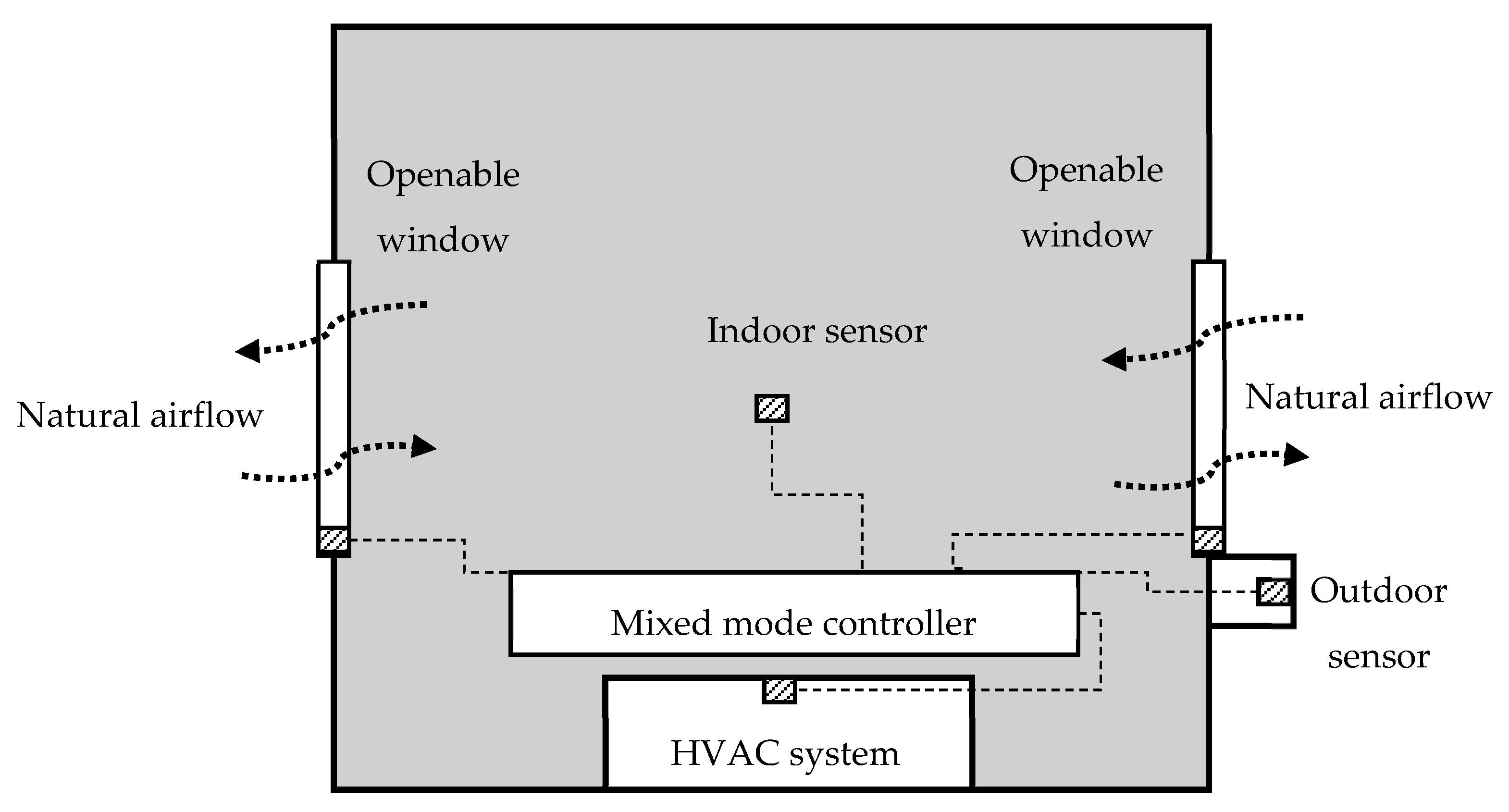1. Introduction
In recent years, the electricity consumption in residential buildings has increased significantly in the U.S, accounting for approximately 47% of the total electricity consumption [
1,
2]. Further, in these residential buildings, 55% of total electricity consumption is used for the heating, cooling, and ventilation (HVAC) system. Many public and private sector efforts and programs focus on identifying opportunities to reduce these consumptive practices, including increasing the energy efficiency of buildings and building systems. Heating, ventilation, and air conditioning systems used to mechanically condition these buildings to improve occupant comfort, consume substantial amounts of electricity in buildings, and are, thus, a strong target for such efforts.
Generally, HVAC systems in U.S. buildings are designed to not open windows or doors when in operation. When considering residential buildings specifically, which are typically single-zone split systems, these systems can be turned off or not in operation during portions of transition seasons, when the weather is mild, and instead, natural ventilation can be used to condition a home. Using such a technique, this would require less energy use during transition seasons by deferring the use of the HVAC system. To accomplish this, this requires the opening of doors and/or windows and mild outdoor temperatures. In some locations, it is required per building code to have operable windows that could be used for this purpose. The New York City Building Code (section 1203) requires the operable area leading outdoors be at least 5% of the total floor area in residential buildings as a mandatory requirement of natural ventilation for any indoor habitable space [
3]; Denver applies the requirement of at least 0.53 m
2 for operable windows in residential buildings [
4]. However, even though there are some requirements for operable windows in some types of buildings, the use of natural ventilation in the U.S. building stock is still low in comparison with buildings in Europe. In detail, the distribution of natural ventilation systems in residential buildings is 100% in Bulgaria, 99% in Italy, 91.75% in Greece, 81.2% in Germany, 64.9% in France, and 52% in Finland [
5].
Another important component for use of operable windows for natural heating, cooling, and ventilation is occupants’ participation, i.e., opening and closing of windows, doors, and/or other openings to facilitate this process. The challenge shown from prior studies of other technologies that required manual operation, such as shading devices, is that residents not only lack the ability to gauge the right timing or correct adjustments to optimally control a system, but also are not always aware of having a mechanical ventilation system altogether [
6]. Therefore, previous studies developed automated blind algorithms to optimize the daylight and energy end-use consumption [
7], or compared automatic shade operation performance with different control algorithms for dynamic windows to manual operation [
8].
Many homeowners operate the HVAC system at all times of the year, regardless of how cool or warm the outside weather is. In European countries, many residents refrain from using mechanical ventilation despite the weather [
6]. This action leads to a missed opportunity in building energy savings if the outdoor temperature is cooler than the indoor temperature in the cooling season and the outdoor temperature is warmer than the indoor temperature in the heating season. Recently, several research works have investigated this to provide solutions, such as the Energy System Integrated Facility at the National Renewable Energy Laboratory, using operable windows to facilitate natural ventilation when weather conditions are determined to be appropriate [
9]. A computer-installed application was developed to alert the occupants in the building in case of the opportunity of energy savings occurs. However, this is not a technique or opportunity that has been well studied in residential buildings in the U.S.
To reduce HVAC energy consumption and increase natural ventilation in the building, the proposed combination of natural ventilation and a conventional mechanical HVAC system can be considered mixed-mode ventilation. The method can still satisfy the thermal comfort while taking advantages of opportunities to reduce energy needs under appropriate weather conditions. In addition, building design provides sufficient natural ventilation opportunity not only linked with the percentage of openable doors/windows but also other issues related to it, e.g., with single-sided natural ventilation [
10,
11]. The Center for the Built Environment [
12] has classified mixed-mode ventilation into three categories, including “change-over”, “concurrent”, and “zoned”. These three methods serve different targets. “Change-over” means only one system, either natural ventilation or a mechanical system, is in operation at the same time. “Concurrent” uses both natural ventilation and an HVAC system at the same time in the same thermal zones. The “zoned” method applies different techniques in different thermal zones of a building.
Mixed-mode ventilation has been studied in several research works. Spindler and Norford [
13] suggested control strategies for mixed-mode ventilation by developing a data-driven thermal model to predict the thermal consumption applied in mixed-mode residential buildings. Hu and Karava [
14] studied the use of particle swarm optimization in a predictive model framework to help schedule cooling fans at night and decide on the appropriate position to open a window. The operational strategy in these two research efforts includes the combination of natural ventilation and fan-assisted ventilation. Additionally, a predictive occupant-centric control system was developed by Zhao et al. [
15] using “change-over” mixed-mode ventilation. Wang and Greenberg [
16] used an Energy Management System (EMS) in EnergyPlus to investigate the mixed-mode ventilation in a “change-over” and a “concurrent” control strategy. This case study found that 17–47% of energy consumption can be saved using mixed-mode ventilation with a reasonable operation set point and opening fraction of a window in summer. Cook et al. [
17] developed strategies for low-energy cooling and ventilation for Indian residences (LECaVIR). In this study, an enhanced natural ventilation mode is applied with appropriately sized openable windows, leading to 46% reduction in the mechanical cooling hours for residences [
17].
In summary, mixed-mode ventilation presents an opportunity for energy savings. Although mixed-mode ventilation and hybrid ventilation have been studied extensively in the past, the large majority of prior research focused on commercial and/or office buildings [
18,
19,
20,
21], despite residential buildings representing nearly half of the electricity consumed by buildings in the U.S [
1,
2]. The optimum of the control strategies on aspects of energy and cost savings in mixed-mode ventilation has studied insufficiently in residential buildings in the U.S. This research uses a large dataset of electricity and energy use in residential buildings, indoor thermal set point, and outdoor weather parameters to quantify the missed opportunities of natural ventilation, as well as proposing a change-over control strategy for mixed-mode ventilation to determine what time to open or close openings in the building envelope to optimize the performance of buildings.
2. Methodology
The methodology used to evaluate the energy and economic benefits in residential HVAC systems using mixed-mode ventilation is proposed in
Figure 1, including four main sections: (1) quality control of energy use dataset in residential buildings; (2) determine the HVAC switch status in heating/cooling mode; (3) evaluate the HVAC mixed-mode ventilation in transition seasons; and (4) evaluate the energy and economic benefits. These major steps are analyzed in the following sections.
2.1. Quality Control of Energy Use Dataset in Residential Buildings
The main purpose of this step is to control the quality of all aspects of residential building data such as collection, filtering, and assessment to ensure the accuracy of input and research outcomes. The residential building data, including the energy use data of HVAC systems and indoor thermal data, are collected from several hundred residential buildings by the nonprofit Pecan Street Research Institute in Austin, Texas [
22]. The main characteristics of HVAC systems in the residential buildings include types of HVAC system, number of compressors, programmable thermostat, ceilings fan, etc. Most of the HVAC systems are the central air gas furnace, accounting for up to 70.6% of total HVAC [
23]. The central air electric furnace and heat pump take 6.6% and 7.5% of total HVAC, respectively [
23]. Besides, 65.5% of HVAC systems have one compressor, and 57.1% of studied houses have a programmable thermostat. Ceiling fans are also used in most residential buildings (90.1%) [
23]. For further information, the architectural and occupancy parameters in residential buildings are demonstrated in
Table 1. The architectural parameters include age of buildings (11 years on average), building area (204 m
2 on average), 2.7 bedrooms (on average), 11.2 windows (on average), 1.3 stories (on average), 32% buildings have basement, 11.2% buildings have attic, major outside wall construction of brick (35.2%), and major roofing material of shingles (57.8%) [
24]. For occupancy information, number of occupants is 2.6 on average, most householders graduated college/are postgraduate, and total annual income ranges differently from (in USD) 50,000–99,999 (24.1%), 100,000–149,999 (32.4%), and over 150,000 (30.6%) [
23]. In fact, the energy and cost savings have significant meaning for all range of residential buildings, especially for low-income households in the background of fuel and energy prices increasing in recent times. Therefore, the savings in HVAC energy use and its related cost provide a significant meaning to these households.
In this research a large dataset of residential buildings with highly granular, disaggregated energy use data is investigated. The general background information of all households includes whole-home electricity data, HVAC system electricity use, indoor temperature parameter, and weather parameters such as outdoor temperature, humidity, solar radiation, and wind speed, etc. [
22]. In order to control the data quality in this research, only houses that have 100% availability of HVAC electricity use considered at the one-minute interval for the time period of transition months were selected from several hundred households. Similarly, the high-frequency thermostat data and outdoor temperature data measured at one-minute level with 100% availability data in transition months are the thresholds to select studied households. After filtering data from several hundred residential buildings, a dataset of 14 houses that have 100% data of HVAC system energy use in transition months are chosen to study. Similarly, the high-frequency thermostat data in these studied residential buildings are the one-minute level indoor temperature also collected in these transition months. The weather data as outdoor temperature and humidity taken in Texas are used to study the difference between outdoor and indoor temperatures. The characteristics of the 14 studied households are represented in
Table 2 in detail. The data are collected through surveys; however, some characteristics are not reported by homeowners or respondents. Each household is anonymized and represented by a unique identification number [
22,
23]. The information in
Table 2 could be helpful to understand more about these selected households.
2.2. Determine the HVAC Switch Status in Heating/Cooling Mode
In order to determine the active time of an HVAC system in heating and cooling mode in transition months exactly, it is necessary to figure out the actual threshold power in each HVAC indoor/outdoor unit. The previous study [
25] defined 0.05 kW as the general threshold power of indoor unit for HVAC on and off switch status. However, after reviewing the whole dataset of HVAC indoor and outdoor units in transition months, there are still outliers or not eligible status in HVAC signal using this threshold power of 0.05 kW. When HVAC is mostly in cooling status, there are still the signals of heating status at the same time. Therefore, by using the HVAC dataset in June, a month in cooling season, the threshold powers of each indoor and outdoor unit are chosen through median values in HVAC indoor/outdoor signal histograms. Following this method, the designated system thresholds for on/off status are obviously different for each studied residential building.
In addition, the HVAC system mechanically takes time to completely switch off or change modes, from heating mode to cooling mode or vice versa. Therefore, this research suggests that five minutes is the minimum time to decide the switched signals of HVAC system. This proposed method could correct the HVAC system status with the different on or off designated threshold power in each studied residential building. Using the new on/off designated thresholds in studied residential buildings, the HVAC system status in heating mode and cooling mode is correctly defined.
2.3. Evaluate the HVAC Mixed-Mode Ventilation in Transition Seasons
In the summer when the outdoor temperature is extremely hot, it is easy to check if the HVAC system status is working properly in cooling mode or not. Similarly, it also checks for the HVAC system status in heating mode when outdoor temperature is cold in winter months. However, in the transition seasons, specifically spring transition months in April/May and fall transition months in October/November, it is challenging to evaluate the effectiveness of HVAC system if the outside weather is comfortable for building occupants and there is the temperature difference between outdoor and indoor temperature. Sometimes the combination of natural ventilation and HVAC system should be applied in some specific times in the transition months, and it could bring unusual opportunities for energy savings in the buildings but still make occupants feel comfortable. Most of the missed opportunities for a reduction in HVAC energy use occur when comparing the indoor and outdoor temperature, as the HVAC system still works in cooling mode when the outdoor temperature is cooler than the indoor temperature, or the heating mode is active when the outdoor temperature is warmer than the indoor temperature. In both cases, it is possible to combine the HVAC system with natural conditioning in indoor building spaces to cool or heat the home to save energy use in the HVAC system.
The ASHRAE Standard 55—Thermal Environmental Conditions for Human Occupancy [
26]—indicates criteria for thermal comfort in both mechanically and naturally conditioned spaces in residential buildings with operable windows with the ranges of allowable indoor operative temperature in natural ventilation but still keeps occupants comfortable, based on both the indoor operative temperature and the mean monthly outdoor temperature. Two ranges of operative temperature limits include 80% acceptable limitation (for typical applications and unavailable other information) and 90% acceptable limitation (for higher thermal comfort standard). In general, if the average studied data are within these acceptability limits, it means that the occupants satisfy thermal conditions using natural ventilation in indoor spaces. In addition, thermal comfort range is specified not only in ASHRAE comfort standard 55 [
26] but also in many ongoing studies [
27,
28]. Baborska-Narożny et al. [
27] studied the comfort levels and the lower and upper limits of an optimum comfort zone in buildings heated with solid fuel, electricity, district heating, and natural gas.
The mixed-mode HVAC system is the combination of natural ventilation from operable windows and mechanical systems for cooling or heating indoor spaces in residential buildings. Mixed-mode systems are becoming more efficient, maximizing comfort while bringing energy benefits and reducing operating costs for building occupants [
12,
29]. The schematic mixed-mode HVAC system is demonstrated in
Figure 2. The internal environment data are collected by the indoor temperature sensor set up in the center of the room with the mixed-mode controller in the HVAC system [
12,
29]. Based on the outdoor sensor and indoor sensor, the mixed-mode controller would decide when the HVAC system or openable windows should be activated as required [
12,
29].
The relationship between the operational and measured temperatures is illustrated in
Figure 3 and
Figure 4. First, the daily mean temperature is examined with measured temperature from the weather observation station [
30] for the certain time and location (
Figure 3). The results from
Figure 3 demonstrate that the daily mean temperature values are appropriate and similar with measured temperature from the observation station. Then, the comparison between operational temperature and measured temperature is demonstrated in
Figure 4. The coefficient of determination (R
2 = 0.94) expresses the high level of correlation between the operational and measured temperatures in the study. The real-time measurement data related to mixed ventilation, including relative humidity (%) and wind speed (km/h), on a typical day in April are also represented in
Figure 5.
In order to evaluate the operation of a mixed-mode ventilation system in each studied single-family residential building, the authors studied the ratio of applying mixed-mode ventilation in the combinations between indoor air and outdoor air. The setting could be at any ratio of indoor air and outdoor air, changing from 100% indoor air setting to 100% outdoor air (only natural air). In this research, four cases with different ratios of using indoor air and outdoor air in transition months have a representative meaning that shows the ratio transformation of indoor air (from 100% to 70%, to 50%, and to 0%) and outdoor air (from 0% to 30%, to 50%, and to 100%). There are three basic study cases, including (a) combination of 70% indoor air and 30% outdoor air, (b) combination of 50% indoor air and 50% outdoor air, (c) using completely 100% outdoor air, with original comparison of using 100% indoor air. To evaluate the mixed-mode ventilation in an HVAC system, the average data with one, two, and three standard deviations in each studied residential building are calculated and compared with two ranges of acceptable limits. The results will assess the appropriate combinations of indoor air and outdoor air for naturally conditioned spaces and the benefits from using mixed-mode ventilation in HVAC systems in residential buildings.
2.4. Evaluate the Energy and Economic Benefits
The benefits of an HVAC system using mixed-mode ventilation is evaluated in two aspects: total HVAC energy use savings (kWh), and cost savings (%). This evaluation is based on the average values from studied residential buildings when using HVAC system on cooling/heating modes in spring transition months (April/May) and fall transition months (October/November). First, the runtime savings for HVAC system (in minutes) is calculated from the time of missed opportunities from using mixed-mode ventilation instead. The evaluation of the missed opportunities is determined by the comparison of indoor and outdoor temperature when the HVAC system is in the heating/cooling mode (step 3). Next, the energy use saving (kWh) in each studied house is calculated from the total HVAC indoor/outdoor energy use in heating/cooling mode that is wasted in the appropriate times from having the indoor/outdoor temperature difference but not using the natural ventilation. Finally, the cost savings in each residential building are calculated from the HVAC energy use savings (kWh) and the unit price (cents per kWh) of electricity use. From the U.S. Energy Information Administration, the average price to residential customers by end-use sector in Texas in October 2021 was 12.56 cents per kWh [
31]. The evaluation of three aspects of savings could demonstrate the strong benefits by the use of mixed-mode ventilation for owners of residential buildings.
3. Results and Discussion
Following the proposed method, the designated HVAC system thresholds for on/off status are determined as different in each studied single-family residential building. The histograms (
Figure 6) summarize the threshold power of both HVAC outdoor and indoor units. The thresholds are from 0.5 kW to 2.5 kW for HVAC outdoor unit signals, and from 0.2 kW to 0.6 kW for HVAC indoor unit signals. In detail, there are approximately 31% and 37% of studied houses having thresholds of 1.5 kW for outdoor units and 0.3 kW for indoor units, respectively. Others are about 25% of total houses having outdoor/indoor unit thresholds of 2 kW and 0.2 KW, respectively. Over 40% of houses have indoor unit thresholds from 0.3 kW to 0.6 kW. The corrected thresholds of HVAC indoor/outdoor could enhance the determination of HVAC runtime in heating and cooling mode in spring/fall transition seasons.
Using the proposed five minutes as the minimum time to decide the switched signals of an HVAC system, the HVAC system status in heating mode and cooling mode is correctly determined and matched with the indoor temperature.
Figure 7 demonstrates the HVAC outdoor/indoor unit signals in cooling/heating mode in a sample house. The HVAC outdoor unit signals in cooling mode are matched with indoor temperature in
Figure 7a by using the HVAC outdoor unit threshold of 0.25 kW. Similarly, the HVAC system status in heating mode in this sample house is determined by the threshold of 0.4995 kW in the HVAC indoor unit (
Figure 7b). In detail, there is a downward trend of indoor temperature when the HVAC is in cooling mode, and oppositely, the indoor temperature increases when the HVAC cooling mode status is off (
Figure 7a). Similarly, the indoor temperature is in an upward trend when the HVAC system heating mode is active and vice versa (
Figure 7b). The matching between HVAC indoor/outdoor unit status in heating/cooling modes and the indoor temperature confirms the suitable development of the on/off designations for the HVAC system in this study.
Using the corrected on/off designated thresholds of an HVAC system in heating/cooling modes in each studied single-family residential building, the mixed-mode ventilation is evaluated by the thermal comfort criteria in ASHRAE 55 [
26]. This research considers four cases with different ratios of using indoor air and outdoor air in transition months, such as (a) 100% indoor air (as a basis of comparison), (b) 70% indoor air and 30% outdoor air, (c) 50% indoor air and 50% outdoor air, and (d) 100% outdoor air, to evaluate the effectiveness of applying mixed-mode ventilation.
Figure 8 demonstrates the studied dataset of missed opportunities for energy savings in these four cases and their trend lines of mean monthly outdoor air temperature and indoor operative temperature. If the average trends in the studied dataset in each case of using indoor air and outdoor air are in line with the ASHRAE criteria (90% acceptable limits), the mixed-mode ventilation in the HVAC system is effective and results in providing thermal comfort to occupants in the residential buildings. By using only indoor air (
Figure 8a), the average trend line is completely inside the 90% acceptable limitation of thermal comfort, because the indoor environmental conditions are controlled mechanically by the HVAC system. In case (b) of mixed-mode ventilation, with 70% indoor air and 30% outdoor air (
Figure 8b), the average trend line still inside the 90% acceptable limitation, but it starts going out of the limitation from under 17 °C of outdoor air temperature. Similarly, the trend line goes out of limitation when the outdoor temperature is under 20 °C, if mixed-mode ventilation uses 50% indoor air and 50% outdoor air (
Figure 8c). Finally, using only outdoor air (100%) in mixed-mode ventilation is inappropriate if the outdoor temperature is under 22.5 °C (
Figure 8d).
The average values of indoor operative temperature in each studied residential building during the transition months with their one (±1), two (±2), and three (±3) standard deviation values are calculated and illustrated in the box and whisker plots with two ranges of acceptable limits to evaluate the efficiency of mixed-mode ventilation in four similar studied cases of using indoor air and outdoor air (
Figure 9). Overall, the average and the ±1, ±2, ±3 standard deviation values are in the range of acceptable limitations in both spring and fall transition months in the case (a) using only 100% indoor air and the case (b) using 70% indoor and 30% outdoor air (
Figure 9a,b). From the combination with under 50% of indoor air and over 50% of outdoor air, as in cases (c) and (d), the −1, −2, −3 standard deviation values are outside of the 80% and 90% acceptability limits when the outdoor air temperature is under 20 °C (
Figure 9c,d). Therefore, the research proposed the mixed-mode ventilation suitable with different outdoor environmental conditions. The natural ventilation with 100% outdoor air in case (d) could be completely applied if the outdoor temperature is over 22.5 °C and under 28 °C, to ensure the appropriate indoor temperature is not too cold in transition season by opening the window. When the outdoor air temperature is from 17 °C to 20 °C, and from 20 °C to 22.5 °C, the mixed-mode ventilation in case (b) 70% indoor air and 30% outdoor air, and case (c) 50% indoor air and 50% outdoor air could be used, respectively, to ensure the thermal comfort when the indoor operative temperature is from 20 °C to 26 °C. Finally, if the outdoor temperature is under 17 °C, as in case (a), only indoor environmental conditions with 100% indoor operative air temperature from 20 °C to 25 °C should be used to ensure comfortable indoor thermal spaces for occupants in residential buildings.
Energy and economic benefits are evaluated in aspects of savings, including total HVAC energy use savings (kWh) and cost savings (%).
Table 3 summarizes the average values from 14 studied residential buildings when using the HVAC system in both cooling mode and heating mode in the spring transition months (April/May) and the fall transition months (October/November). The HVAC on/off system working per period (spring/fall transition months) in a residential building is demonstrated in
Figure 10. Most of the HVAC runtime savings come from the cooling mode in the transition months, accounting for 89.6% to 97.3% of total runtime savings. Only 10.4% and 2.7% of total runtime savings sequentially are for heating mode in spring and fall transition months. By saving the HVAC runtime, the total energy use savings in the HVAC system in each residential building are 150.79 kWh and 143.86 kWh, on average, for spring and fall transition months, respectively. Mostly, over 90% of total energy use is saved from the HVAC outdoor unit in cooling mode. Therefore, the household owner could save, on average, from 24.41% to 27.2% of HVAC cost in each residential building in the spring and fall transition months.
Table 4 compares the average energy use consumption by mechanical ventilation with the energy use savings by mixed-mode ventilation from a typical residential building in the spring transition months (April and May) and the fall transition months (October and November). These savings not only provide an important meaning about energy and economic benefits for household owners but also still maintain thermal comfort for occupants in residential buildings.
4. Conclusions
The study results demonstrate the strong energy and economic benefits for savings in the HVAC runtime, total HVAC energy use, and its cost, by using the mixed-mode ventilation for natural environmental conditioning spaces in residential buildings. The opportunities for these energy and economic savings are usually missed when the HVAC system runs in cooling mode but the outdoor temperature is cooler than the indoor temperature in cooling seasons, and the HVAC status is in heating mode while the outdoor temperature is warmer than the indoor temperature in heating seasons. Approximately 150.79 kWh of total HVAC energy use, and 24.41% of HVAC cost in spring transition months (April/May) could be saved from mixed-mode ventilation, and similarly, 143.86 kWh of energy use, and 27.2% cost savings in fall transition months (October/November). Most energy and financial benefits came from when the HVAC system works appropriately by using mixed-mode ventilation. The results from the studied residential buildings in Austin, Texas, also represent that their HVAC system could apply the mixed mode for natural ventilation up to approximately 30–50% outdoor air in some times in transition seasons but still ensure thermal comfort for occupants in their houses, contributing to energy use reduction in residential buildings.
Although the study results contribute significantly to energy and economic benefits for householders, there are still some limitations that need to be studied further. First, only one parameter of indoor environment data (indoor temperature) and one parameter of outdoor weather data (outdoor temperature) are applied for the comparison of the HVAC system in cooling mode and heating mode in spring and fall transition months. In addition, other weather parameters, such as humidity, temperature, wind speed, solar radiation, and other internal parameters related to mixed ventilation, will be studied sufficiently in subsequent research. Second, the research should be expanded in diverse types of residential buildings with different comfort categories in multiple climate zones [
32,
33,
34,
35] to evaluate the operation of mixed-mode ventilation effectively in different climate regions and other aspects of energy/cost savings better. In addition, further study should practice research results using dynamic energy simulations in different cases, as well as analyze the relationship between the operation of mixed-mode ventilation and filtration in an HVAC system affected by the indoor/outdoor environment [
36,
37,
38,
39,
40,
41,
42].
The findings of this study have significance, in particular, for residential building HVAC systems, energy efficiency, and cost savings. The application of this study not only has benefits for householders and occupants in residential buildings from the effective operation of mixed-mode ventilation in heating or cooling mode appropriately to ensure the thermal comfort for occupants in their houses, but also contributes to energy use and cost reduction in residential buildings toward sustainable development.

